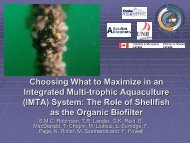Integrated multi-trophic aquaculture (IMTA) in marine temperate waters
Integrated multi-trophic aquaculture (IMTA) in marine temperate waters
Integrated multi-trophic aquaculture (IMTA) in marine temperate waters
You also want an ePaper? Increase the reach of your titles
YUMPU automatically turns print PDFs into web optimized ePapers that Google loves.
<strong>Integrated</strong> <strong>multi</strong>-<strong>trophic</strong> <strong>aquaculture</strong> (<strong>IMTA</strong>) <strong>in</strong> mar<strong>in</strong>e <strong>temperate</strong> <strong>waters</strong> 21<br />
<strong>IMTA</strong> sites have rema<strong>in</strong>ed at a small scale level, primarily because the explosive<br />
growth of salmon <strong>aquaculture</strong> prevented the adoption of alternative farm<strong>in</strong>g strategies,<br />
like <strong>IMTA</strong>, as the <strong>in</strong>dustry had no immediate <strong>in</strong>centive to modify a very successful<br />
f<strong>in</strong>ancial story. It has not been easy to adopt an <strong>IMTA</strong> approach <strong>in</strong> Chile. Like oriental<br />
countries, Chile has a long tradition of shellfish and seaweed consumption; however,<br />
the price for these goods is very low, therefore, they cannot be suggested as an<br />
<strong>in</strong>terest<strong>in</strong>g bus<strong>in</strong>ess for <strong>in</strong>vestors. To encourage the farm<strong>in</strong>g of these organisms, novel<br />
uses of seaweeds are be<strong>in</strong>g developed (A. Buschmann, pers. comm.). Present licens<strong>in</strong>g<br />
regulations also offer no <strong>in</strong>centives for the adoption of <strong>IMTA</strong> practices, especially as<br />
it does not encourage partnership between site owners <strong>in</strong>volved <strong>in</strong> produc<strong>in</strong>g different<br />
crops, or their association with<strong>in</strong> one site. It is unlikely that the owner of a large<br />
<strong>in</strong>tensive salmon farm will <strong>in</strong>vest and make the effort of grow<strong>in</strong>g seaweeds and mussels<br />
unless regulations would stipulate that the implementation of <strong>IMTA</strong> practices would<br />
allow to <strong>in</strong>crease the number of fish be<strong>in</strong>g raised at the site or would lower penalties<br />
related to environmental effects levied by the authorities. Most parameters monitored<br />
for the environmental assessment of salmon farm<strong>in</strong>g focused on the state of the bottom<br />
under the cages and ignored issues encountered <strong>in</strong> the water column and <strong>waters</strong>hed (e.g.<br />
nutrients), where <strong>IMTA</strong> could have a significant effect. If regulations were to address<br />
concerns of cumulative impacts and eu<strong>trophic</strong>ation at larger scale (fjords, channels, or<br />
whole bays), <strong>in</strong>stead of focus<strong>in</strong>g on local bottom effects, farmers would then become<br />
more <strong>in</strong>cl<strong>in</strong>ed to adopt <strong>IMTA</strong>, especially if the implementation of such practices can be<br />
associated with recognition through certification systems or eco-labell<strong>in</strong>g.<br />
Other <strong>IMTA</strong> <strong>in</strong>itiatives, both at freshwater and mar<strong>in</strong>e <strong>aquaculture</strong> sites, have been<br />
experimentally pursued. For example, the use of artificial reefs around and below<br />
salmon cages to enhance ecosystem restoration and to <strong>in</strong>crease the production of crabs<br />
and other fish have been attempted (Soto and Mena, 1999; Soto and Jara, 2007).<br />
An <strong>in</strong>terest<strong>in</strong>g situation has emerged <strong>in</strong> southern Chile with the recent development<br />
of mussel (Mytilus chilensis) cultivation. Mussel long l<strong>in</strong>es can now be found between<br />
salmon cages <strong>in</strong> channels and fjords due to space limitations <strong>in</strong> the region. The<br />
decisions regard<strong>in</strong>g the design and location of sites were, however, not based on<br />
scientific data for prevail<strong>in</strong>g currents, suspended matter and nutrient circulation,<br />
oxygen availability, etc. and the <strong>IMTA</strong> concept was not explicitly considered, despite<br />
the fact that it has been documented that natural mussel beds near salmon farms can<br />
utilize these nutrients and particulate matter (Soto and Jara, 2007). Better pre-plann<strong>in</strong>g<br />
of these coastal zones, by <strong>in</strong>clusion of the <strong>IMTA</strong> pr<strong>in</strong>ciples, would represent much<br />
better management practices.<br />
The development of abalone cultivation is presently emerg<strong>in</strong>g <strong>in</strong> Chile, add<strong>in</strong>g an<br />
extra pressure on natural resources of seaweeds as a source of feed. A pilot scale farm<br />
(4-5 ha) is already produc<strong>in</strong>g the brown alga Macrocystis pyrifera and has demonstrated<br />
its technical and economic feasibility. L<strong>in</strong>k<strong>in</strong>g salmon <strong>aquaculture</strong> (the source of<br />
nutrients for seaweeds) with seaweed <strong>aquaculture</strong> (the source of food for abalone) and<br />
abalone <strong>aquaculture</strong> (the f<strong>in</strong>al recipient of the food and energy passed along) could<br />
represent another <strong>in</strong>terest<strong>in</strong>g <strong>IMTA</strong> system.<br />
One potential problem with the <strong>in</strong>tegrated culture of seaweed-salmon farms is the<br />
spread of the <strong>in</strong>vasive species Codium fragile ssp. tomentosoides. This <strong>in</strong>vasive alga<br />
competes for nutrients with Gracilaria (Neill et al., 2006), which could reduce biomass<br />
and agar quality. The spread of this alga needs to be monitored and controlled if<br />
possible to prevent losses to the <strong>in</strong>dustry.<br />
The development of <strong>IMTA</strong> systems <strong>in</strong> Chile should be a high priority with the<br />
government and <strong>in</strong>dustry officials. Due to the high production volumes and rapid<br />
expansion of the salmon culture <strong>in</strong>dustry (FAO, 2006a), the risk of environmental<br />
degradation is high if salmon effluents are not managed and mitigated. <strong>IMTA</strong> systems<br />
can help prevent environmental degradation, while support<strong>in</strong>g an <strong>in</strong>dustry with high



